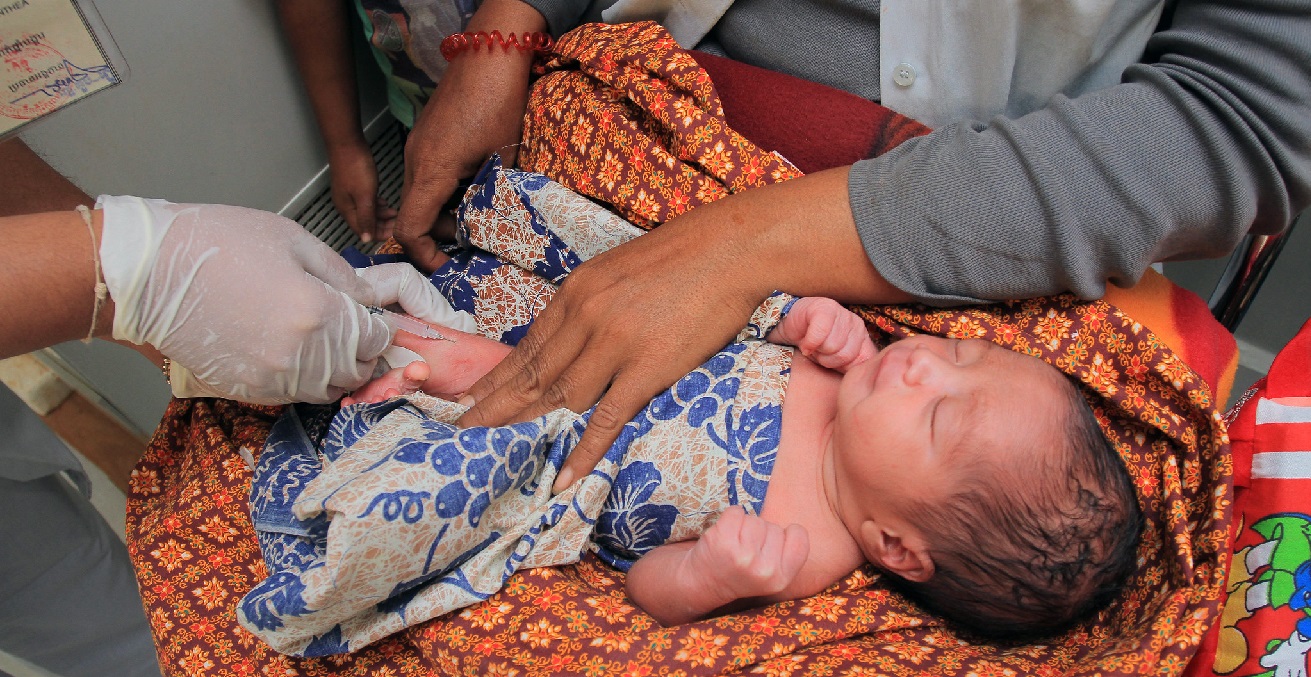Supporting Communication and Improving Uptake of Maternal and Childhood Vaccines

Despite reductions in global maternal and child mortality over the last two decades there is still room for improvement, especially in low and middle income countries (LMICs). Pregnancy is a critical time for the promotion and protection of maternal and child health through vaccination.
In the Asia Pacific region, nine out of ten maternal deaths are preventable, and infectious diseases are a major cause of maternal and child morbidity and mortality. Pregnant women are more than twice as likely as other adults to be hospitalised or experience serious complications from seasonal influenza. Severe influenza infection during pregnancy can also lead to premature delivery or still birth. Newborns are especially vulnerable to respiratory infections, such as pertussis and influenza, with hospitalisation required for nine in ten babies under six months with pertussis and death in 1 in 200.
Maternal vaccination reduces neonatal and maternal morbidity and mortality, reduces stillbirths and pre-term labour, and reduces hospitalisation and healthcare costs. Maternal vaccines are currently recommended for influenza and pertussis, with other vaccines such as Respiratory Syncytial Virus (RSV) and Group B Streptococcus (GBS) in the pipeline. An infant’s immune system is less well developed than an adult’s and infants don’t receive most of their vaccines, including pertussis, until six weeks of age, leaving them vulnerable for this time period without maternal vaccination. For influenza, an infant can only be vaccinated from six months. Influenza and pertussis vaccines have both been shown to be safe and effective during pregnancy for both the pregnant woman and her infant. Influenza is recommended annually, at any time in pregnancy, and pertussis is now recommended from 20 weeks with each pregnancy in Australia. Both the influenza and pertussis vaccines provide two for one protection for pregnant women and their infants in the first months of life through transplacental transfer of maternal antibodies to the infant. This is particularly true for influenza as pertussis infection in the pregnant women is usually not life threatening.
Current World Health Organization (WHO) recommendations for maternal vaccination include tetanus, pertussis, and influenza, but vary by setting. However, while all countries have routine childhood immunisation programs, vaccines in pregnancy are not universally recommended or provided. Very few countries have established programs for maternal pertussis vaccination, and only 12 of 27 WHO Western Pacific member states had influenza immunisation policies targeting pregnant women in 2014. Globally, maternal vaccination is less common in LMIC settings with only 13 percent (11/83) of LMICs having maternal influenza immunisation policies in 2014 compared to 74 percent (70/95) of upper middle- and high-income countries.
In Australia, a maternal influenza vaccine has been recommended since 2010 and pertussis since 2015, with coverage currently around 80 percent for pertussis and 30-50 percent for influenza. Where maternal vaccines are available, antenatal healthcare providers confidently discussing and recommending maternal and childhood vaccines – as well as facilitating access, where possible – is paramount to effective delivery and uptake. Antenatal providers may be general practitioners (GPs), obstetricians, nurses, midwives, lay health workers, or traditional birth attendants. In Australia, midwives are among the most trusted and frequently accessed sources of information for expectant parents. Receiving a recommendation to vaccinate from a trusted healthcare provider – regardless of their specific designation – is the primary driver of vaccine uptake among pregnant women. However, not all providers receive training about maternal vaccination.
The Australian MumBubVax intervention
MumBubVax is an intervention developed with midwives and GPs in Australia to optimise antenatal vaccine discussions and promote maternal and childhood vaccination. The MumBubVax intervention includes communication training for antenatal providers, reminders and prompts for both providers and pregnant women, and informational resources for providers and expectant parents. These strategies are for every level of the healthcare encounter – practices, providers, and patients – to target the majority of barriers to vaccination.
Central to MumBubVax is “VaxChat,” an online Continuing Professional Development training module in communication skills and vaccine information at the provider level. VaxChat applies evidence-based principles of communication based on motivational interviewing techniques and provides the key information sought by the majority of expectant parents on disease severity and vaccine safety and efficacy. The MumBubVax communication approach includes six steps for providers:
- Recommending vaccination: Providers make a clear recommendation to vaccinate and frame vaccination as the routine standard of care.
- Eliciting concerns: Providers ask expectant parents about their questions or concerns.
- Sharing knowledge: Most parents want to know whether the vaccines are safe and how well they work, so providers addressing their questions with one to two key facts about vaccine safety and effectiveness, with resources or links to more detailed information if requested.
- Focusing back on disease severity: Rather than focusing on myths or concerns about vaccines, providers bring the discussion back to the diseases vaccines prevent, emphasising that vaccination is the single best way to protect themselves and their babies from vaccine-preventable diseases.
- Facilitating vaccination: If available, providers offer women the recommended vaccines on site or advise where they can go to be vaccinated.
- Continuing the conversation: Providers discuss vaccination throughout pregnancy, introducing maternal vaccine discussions from the first visit, and begin discussing childhood vaccines before birth.
The online modules are designed to be short and convenient for providers to watch on their own, but they can also form the basis of group education sessions. The VaxChat training is supported by short learning exercises to optimise skill development. The MumBubVax package also includes sticker prompts for providers to record vaccine discussions or delivery on women’s antenatal charts and text message reminders for women to receive influenza and pertussis vaccines after their antenatal visits. The text message reminders are sent by the clinic one and two weeks after the antenatal appointment with the option to reply once the women had received the vaccine. The detailed MumBubVax website offers providers and expectant parents detailed information about vaccine safety and effectiveness, as well as printable fact sheets on maternal influenza, pertussis, and infant hepatitis B vaccine.
Adapting and applying MumBubVax globally
The burden of these vaccine-preventable diseases for women and their infants in LMICs is high. Overcoming this requires the development and promotion of new approaches, tools, and policies for vaccine communication, education, and delivery to maximise uptake. Procurement and prioritisation by countries is the first step, followed by effective vaccine delivery and access. It is equally important to invest in the capacity of the healthcare work force to deliver maternal immunisation with effective communication and education training. This is relevant both in countries with established and expanding vaccine programs, as well as in places where maternal vaccine programs may be at their inception.
As more countries begin to recommend maternal vaccines and prepare for the new maternal vaccine candidates, such as for RSV and GBS, it is important to address the barriers to introduction, delivery, and uptake of maternal vaccines. Expectant parents need information on the severity and impact of these vaccine-preventable diseases and to be reassured about their safety and effectiveness. Healthcare providers need the communication and education tools to be immunisation champions and policymakers need to be engaged early to inform the pre-implementation agenda.
The MumBubVax intervention package can help provide training, education, and support for antenatal healthcare providers to effectively communicate about vaccines. Although developed for GPs in the community and midwives in maternal hospitals across Australia, it could be adapted and utilised by other antenatal care providers, or integrated into educational curricula, in LMICs. The evidence-based communication techniques and facts about vaccine safety and effectiveness are widely applicable and provide an opportunity for to enhance maternal vaccine delivery and uptake more broadly, particularly in LMICs.
Jane Tuckerman is a member of the Vaccine Acceptance, Uptake, and Policy research group at the Murdoch Children’s Research Institute in Parkville, VIC, Australia
Dr Jessica Kaufman is a postdoctoral researcher in the Vaccine Acceptance, Uptake, and Policy group at the Murdoch Children’s Research Institute. She is an honorary fellow of the University of Melbourne.
Associate Professor Margie Danchin is the consultant paediatrician at the Royal Children’s Hospital and within the Department of Paediatrics at the University of Melbourne and Murdoch Childrens Research Institute. She is Group Leader of the Vaccine Acceptance, Uptake, and Policy and is an immunisation expert with over ten years of experience in vaccine research and clinical work, both in Australia and in resource poor settings., Parkville, VIC, Australia
This article is published under a Creative Commons Licence and may be republished with attribution.




